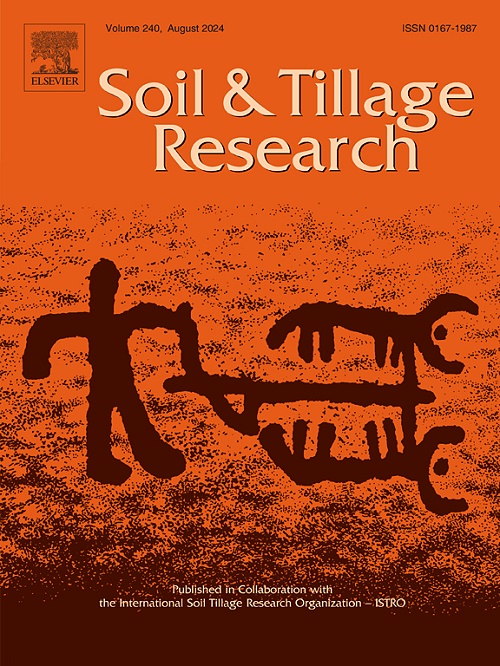Impacts of landscape factors on gully retreat and its morphological characteristics in hilly areas of Northeast China
IF 6.1
1区 农林科学
Q1 SOIL SCIENCE
引用次数: 0
Abstract
The black soil region in Northeast China is an important commodity grain base. In recent years, with the intensification of agricultural activities, the formation and development of gullies on sloping farmland have accelerated, severely affecting food and ecological security. In order to effectively control regional soil erosion, this study comprehensively utilized historical databases of gullies, remote sensing images, field surveys, spatial analysis, and multivariate statistical techniques to reveal the morphological characteristics, development rates, and main driving factors of 116 gullies in typical agricultural watersheds in the low hills of Northeast China. The results showed that linear gully retreat rate in the study area ranged from 4.3 to 8.4 m y−1, with an average of approximately 6.34 m y−1, between 2011 and 2021. The areal gully retreat rate ranged from 90.7 to 1224.4 m2 y−1, with an average growth rate of approximately 339.17 m2 y−1. Compared with other regions in the world, the development rate of gullies in black soil region of Northeast China is relatively fast, especially in terms of lateral expansion, which is about 7 times greater than longitudinal extension. Gully side-wall retreat (approximately 56.8 m2 y−1) was found to be the dominant factor influencing the change in gully area. Environmental variables explained 60.2 % of the variation in gully morphological characteristics, with natural factors having a greater impact on the linear development of gullies than human factors. However, human factors were closely related to lateral expansion. Due to the large proportion of agricultural landscapes and high spatial homogeneity in the study area, micro-topographic features (such as catchment area and elevation) and the spatial configuration of agricultural landscape patches (patch density and edge density) were identified as the main influencing factors of gully erosion development in study area. Therefore, targeted measures and control strategies should be designed based on a comprehensive assessment of terrain factors and landscape pattern indicators to mitigate gully erosion risks. In the future, based on obtaining more three-dimensional data of gullies, empirical coefficient equations should be constructed using gully area and length as independent variables to predict gully volume. This will help identify the main factors influencing sediment and organic matter loss caused by gully erosion in black soil region, and provide technical support for improving the predictive capabilities of gully erosion risks and developing more rational prevention and control strategies.
景观因子对东北丘陵区沟壑退缩的影响及其形态特征
东北黑土地区是中国重要的商品粮基地。近年来,随着农业活动的加剧,坡耕地沟壑的形成和发展加快,严重影响了粮食安全与生态安全。为了有效控制区域土壤侵蚀,综合利用沟壑历史数据库、遥感影像、野外调查、空间分析和多元统计等技术,揭示了东北低丘典型农业流域116条沟壑的形态特征、发育速率及其主要驱动因素。结果表明:2011 - 2021年,研究区沟谷退缩率为4.3 ~ 8.4 m y−1,平均约为6.34 m y−1;沟面退缩率为90.7 ~ 1224.4 m2 y−1,平均生长率约为339.17 m2 y−1。与世界其他地区相比,东北黑土区沟槽发育速度较快,特别是横向扩展速度约为纵向扩展速度的7倍。沟槽侧壁退缩(约56.8 m2 y−1)是影响沟槽面积变化的主要因素。环境变量对沟壑形态特征变化的贡献率为60.2 %,自然因素对沟壑线性发育的影响大于人为因素。然而,人为因素与侧方扩张密切相关。研究区农业景观占比大,空间均匀性高,微地形特征(流域面积、高程)和农业景观斑块的空间配置(斑块密度、边缘密度)是影响研究区沟蚀发展的主要因素。因此,应在综合评价地形因素和景观格局指标的基础上,设计有针对性的措施和控制策略,以减轻沟壑区侵蚀风险。今后,在获取更多沟槽三维数据的基础上,应以沟槽面积和沟槽长度为自变量,构建经验系数方程来预测沟槽体积。这将有助于识别黑土区沟蚀导致泥沙和有机质流失的主要影响因素,为提高沟蚀风险预测能力和制定更合理的防治策略提供技术支持。
本文章由计算机程序翻译,如有差异,请以英文原文为准。
求助全文
约1分钟内获得全文
求助全文
来源期刊

Soil & Tillage Research
农林科学-土壤科学
CiteScore
13.00
自引率
6.20%
发文量
266
审稿时长
5 months
期刊介绍:
Soil & Tillage Research examines the physical, chemical and biological changes in the soil caused by tillage and field traffic. Manuscripts will be considered on aspects of soil science, physics, technology, mechanization and applied engineering for a sustainable balance among productivity, environmental quality and profitability. The following are examples of suitable topics within the scope of the journal of Soil and Tillage Research:
The agricultural and biosystems engineering associated with tillage (including no-tillage, reduced-tillage and direct drilling), irrigation and drainage, crops and crop rotations, fertilization, rehabilitation of mine spoils and processes used to modify soils. Soil change effects on establishment and yield of crops, growth of plants and roots, structure and erosion of soil, cycling of carbon and nutrients, greenhouse gas emissions, leaching, runoff and other processes that affect environmental quality. Characterization or modeling of tillage and field traffic responses, soil, climate, or topographic effects, soil deformation processes, tillage tools, traction devices, energy requirements, economics, surface and subsurface water quality effects, tillage effects on weed, pest and disease control, and their interactions.
 求助内容:
求助内容: 应助结果提醒方式:
应助结果提醒方式:


